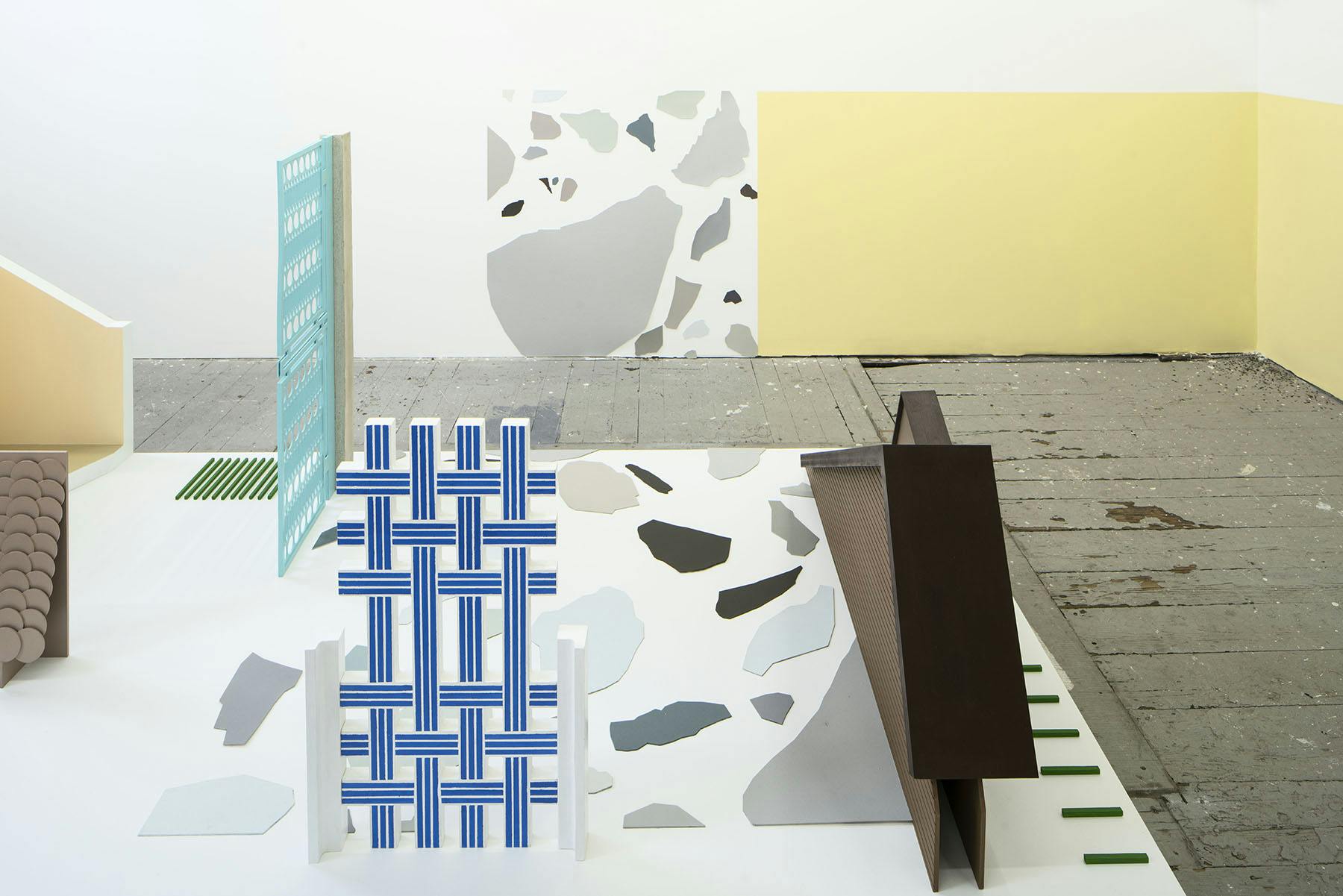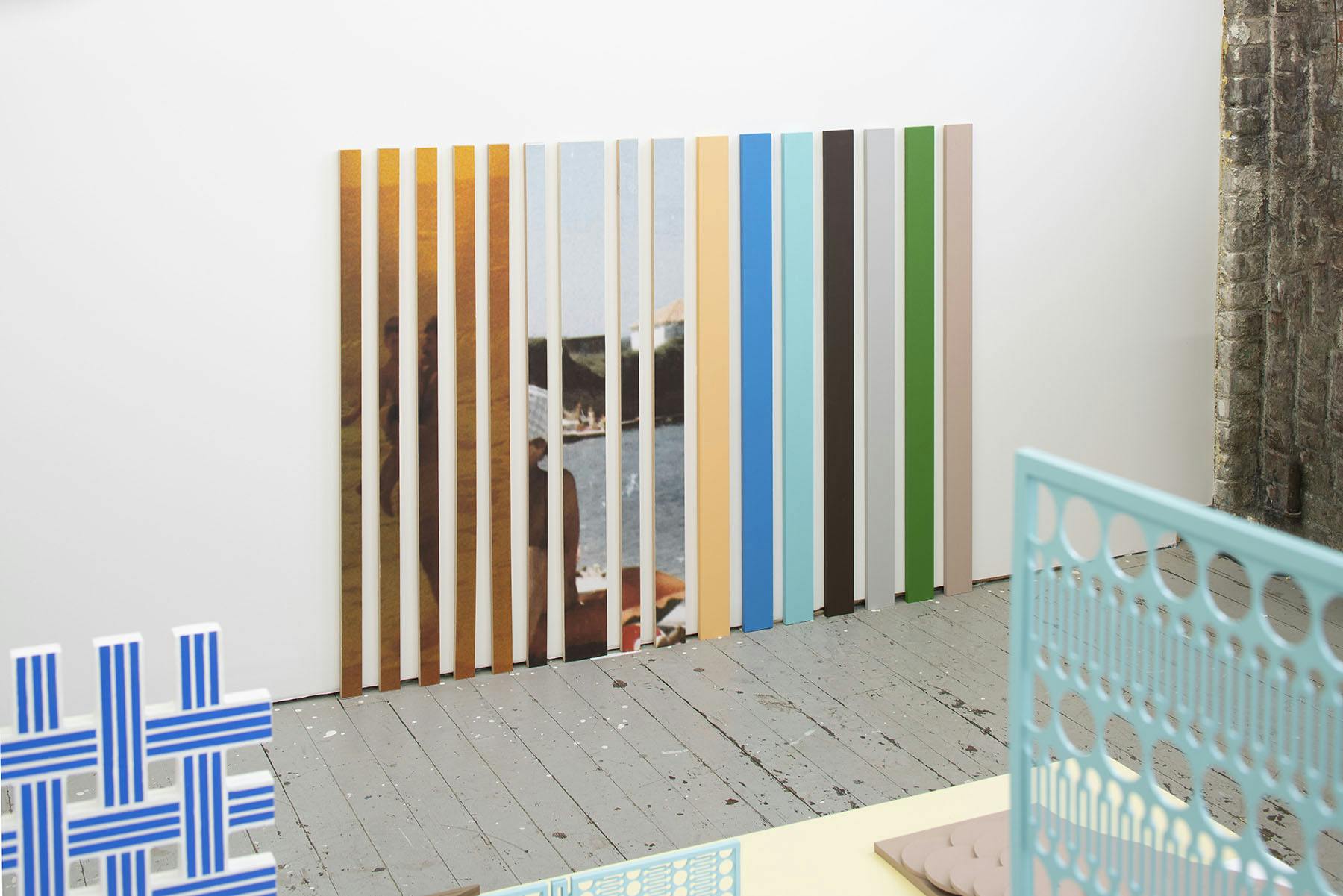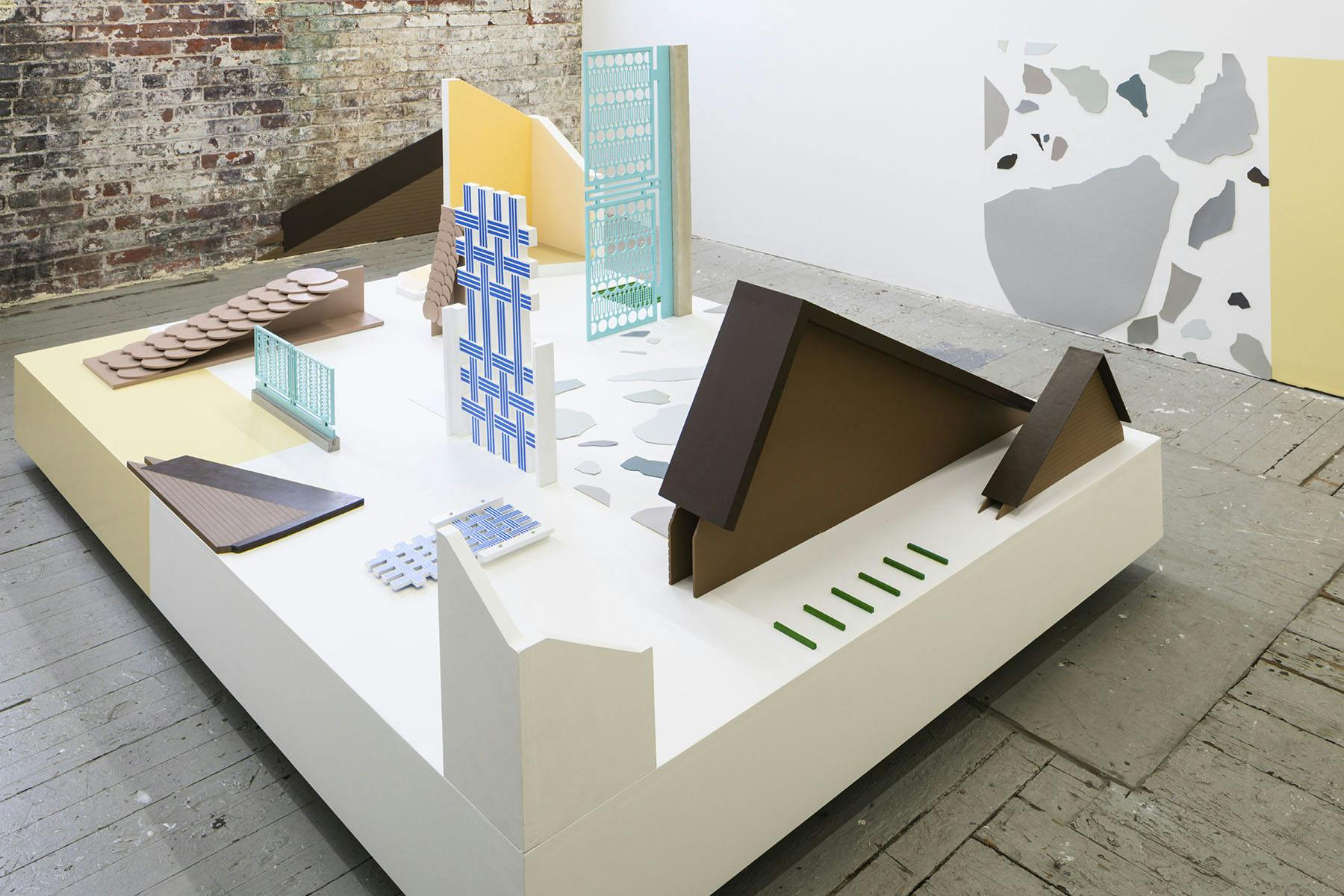The choice of the word “low” in the title of Katarina Burin and Farhad Mirza’s “a low storey between two others” at Anthony Greaney, is telling. Not only is the work situated close to the ground, with work hovering on a pedestal and against the walls just above the gallery’s rough floors, but it’s also very much a low-frequency transaction between the artists and the viewer. That is to say, the information encoded into the work, while open to interpretation, presents a resilient corridor of both obfuscation, and conversely, openness. It is a public gesture with privacy at its root; where the tensions between these two opposing impulses reside together, not uncomfortably, but certainly complicit. Despite the act of withholding information—information seeded with biography and memory—a lot gets said. The signifiers used throughout the installation include gates, fences, and rooftops that are subtly designed to enclose and protect the narratives, symbols, and memories within.
Certainly, and especially now, these gestures are freighted. What becomes of personal recollection without an actual narrative? Places, objects, and stories are alluded to in the fragile configuration of the work, but the two collaborators are reticent to walk the viewer down a concise path. The telltale signs of habitation and biographical fragments are present; architectural details such as stairwells and floorboards dovetail elegantly into nothingness. Here, there are no structures, just the ephemeral illusions of them.
The beauty and integrity of the work is sheathed in reserve. There is no direct representation and nowhere to posit an idea that anchors itself outside the piece. It is a distinct ecosystem, pulsing with ideas and concepts that resist a single approach. Indeed, the various strands woven into the piece (both personal and art historical) provide an armature of privacy and discretion that feels like an act of resistance, a rarity in an increasingly, share it all world.
Farhad Mirza was born in Karachi, Pakistan. He received a Master of Architecture at the Graduate School of Design at Harvard and is currently living in Vermont, where he teaches in the art department at Bennington College. Katarina Burin was born in Bratislava, Slovakia, and received her Master of Fine Art at Yale University spending time in Canada and Berlin before moving to Cambridge in 2010. She is currently lecturer at Harvard University’s Art, Film and Visual Studies department. Farhad and Katarina met in Cambridge, Massachusetts in 2016 and recently began working together after discovering a shared interest in the representation of personal experience and spatial memory through drawing, design, and architecture. Robert Moeller is an artist, writer, and independent curator. He runs the Cost Annex, a project/exhibition space in Boston.
The three of us spoke recently about Katarina and Farhad’s installation “a low storey between two others” which they exhibited at Anthony Greaney in Somerville, MA.
Robert Moeller: Under the best of circumstances, the act of collaboration can be fraught, even if a singular vision of the finished work is previously agreed upon. How did the two of you navigate through the process of working together despite different backgrounds and areas of expertise?
Farhad Mirza: I don’t think we would have collaborated if we didn’t actually enjoy each other’s company—so that came first. And then working together just felt like another way of being together. I think there was already a level of trust and a mutual love of drawings (as tools or shadows of ideas) that was foundational. After that our routines that formed around the making of the work—cooking and eating together, exercising, looking at books, just talking and ruminating—were as important as the object making. I was also grateful to have a witness to some of the time I would normally spend sketching and thinking alone—having someone to talk to in those moments, and the conversations that happened as a result helped turn stray thoughts or ideas into more substantive things.
Katarina Burin: I always need to make a move of some sort in the studio when working, in order to see the object or thing come to be. Then I respond to that thing in front of me, it’s a conversation with the materials and the process—a back and forth—and only then can I make the next move. Farhad works differently and conceptualizes things much more beforehand, which makes him more able to articulate the thinking and ideas behind the work, which I really appreciate and try to learn from. In that way, we made a really great team. It was our first time truly collaborating so it was impossible to know how it would play out at first. There were some beautiful unexpected moments for me, because I was driving out to Vermont to work with him on some weekends—the collaboration was much more about the whole situation and the circuitous conversations that led to a more intimate place, like our respective pasts, which perhaps explains the more personal nature of this particular exhibition.
RM: The work feels like a distillation of all these things you describe doing together. A whittled-down and parsed exploration of memory and identity that accrues over the course of time, honed by conversation and shared ideas. The work, in a sense, becomes encoded with this sort of minimalist shorthand filled with your thoughts and gestures, yet remains utterly private as well. Is that a fair observation?
FM: I think it’s fair to say that the work remains private. Though we (Katarina and myself) did not address this directly, privacy as a quality and an experience is something I value deeply about any art, both as maker or reader. I think if the work seems encoded, that this comes from a desire to communicate non-verbally or say things sideways; where particular words, shapes, and colors gain and lose meaning because of proximity to each other, but also because of strangely placed specificity that doesn’t quite make a coherent, or stabilized, narrative whole.
KB: People want to know the exact translation of things, and this became a little frustrating for us, because we never wanted the work to be about that kind of direct representation. So I would say… it’s really nice that you see the distillation and shorthand, I love that word, and that you see it as remaining private.
RM: This side language you’ve both developed centers on memory not only as an act but also as a signifier of other, mainly art-historical actions that you’ve brought into the conversation. It seems to function as a kind of rough guide to other theoretical and conceptual working methods yet updated and refreshed. Is there an art historical piece woven in here as well?
KB: It’s difficult to separate out the methods and actions from the learned and inherited art historical and design knowledge. Farhad and I don’t separate art from design very readily, but of course there are many working methods referenced and deployed, conversations about specific processes and artists were very much a part of our working time together.
FM: I think in our work together remembering, rather than memory itself, became a mirror for (or reference to) the historical means and methods that we used to make these images and objects. We were curious about axonometric projection in this way—how a representational technique that developed for its ability to be measured might operate while rendering highly subjective, partial and personal spatial recollections. It’s funny that you use the phrase ‘side language’ because I think our conversation with art historical movements sort of manifested itself in literal, physical sides: things on their sides, sheet materials, and flattened objects.
RM: Interestingly, we are finally talking about what could be called a description of the work and its very concrete presence. And yet the piece has the ability to deflect any queries that a viewer might have before realigning itself somewhere else, morphing into a kind of new geography of ideas and encoded information. Was this sort of elusiveness built into the project at the beginning or did it evolve as the work unfolded?
KB: It is fitting that you say its very concrete presence, because it strangely points to the subtle contradiction in the work and in what we were trying to achieve; an opposition of making quite concrete objects that refer to very elusive thoughts and images. It would be my goal at least, to be able to communicate that in the work itself somehow. The subject matter was elusive but the process of working was more specific, if that makes any sense at all?
FM: It was kind of in the room from the start. But I don’t know if we knew when we began how conspicuous and permanent it would become. At some point I think it felt so fundamental to the work that we gave the shiftiness (or reluctance to land) its own representation. The doubling, scaling, and moving between the surfaces of the objects and the gallery itself were about trying to anchor that sense of levity, or at least acknowledge it and stay with it for a while—as an exploration of what it might be to linger in the areas between clear categories or topics. Having said that, it’s all contained within a material and color language so it’s not so much about un-specificity as opposed to covertly targeted specificity. Like the thing the specificity is working toward remains elusive because it never really emerged for us in so many words, but as a feeling instead.
Katarina Burin and Farhad Mirza, a low storey between two others is on view at Anthony Greaney, 438 Somerville Ave., Somerville, through December 7.
The exhibition is accompanied by a publication edited by Katarina Burin and Cambridge-based writer Claire Barliant titled Museum Memories with writing from Judith Barry, Jennifer Paige Cohen, Anna Craycroft, Sarah Crowner, A.S. Hamrah, Matt Keegan, Byron Kim, Alexandra Leykauf, John Menick, Ara Merjian, Daisy Nam, Jenny Perlin, Stephen Prina, Meg Rotzel, Matt Saunders, Shelly Silver, and Herb Tam.



